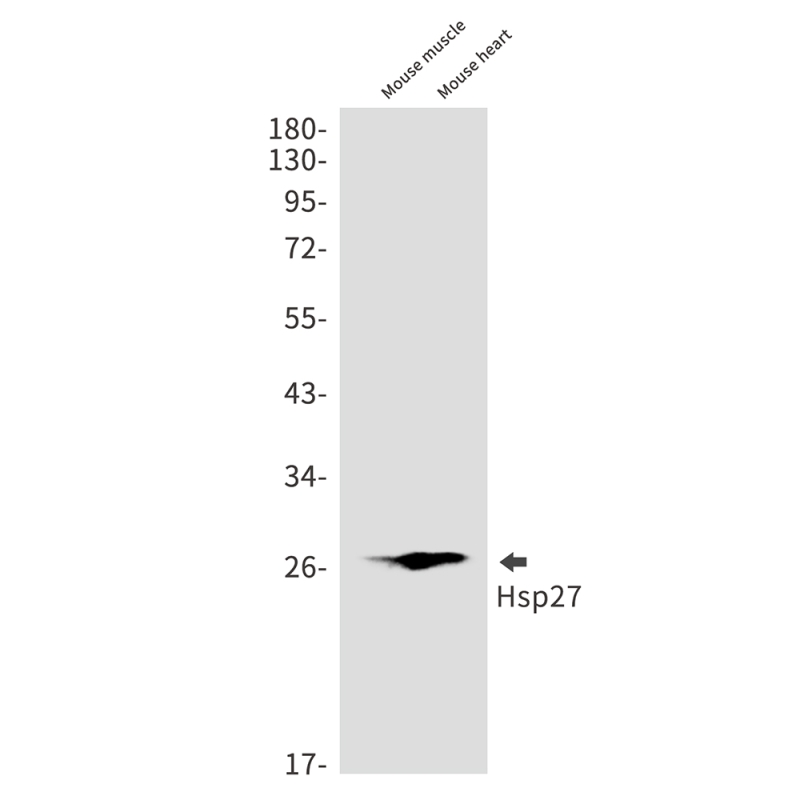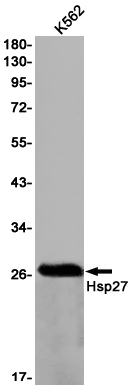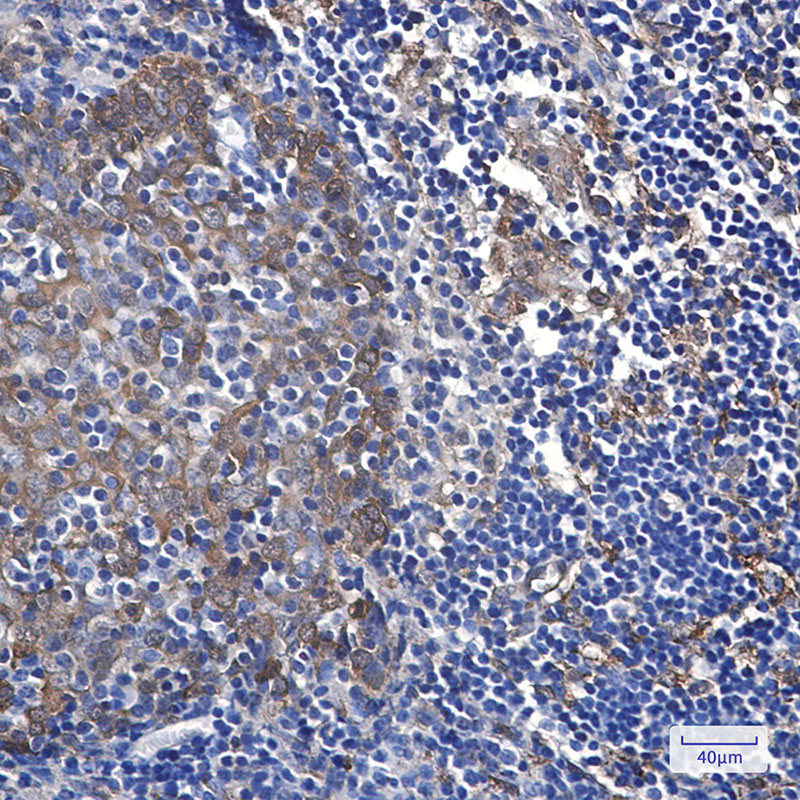


| WB | 1/500-1/1000 | Human,Mouse,Rat |
| IF | 1/20 | Human,Mouse,Rat |
| IHC | 1/50-1/100 | Human,Mouse,Rat |
| ICC | 1/50-1/200 | Human,Mouse,Rat |
| FCM | 咨询技术 | Human,Mouse,Rat |
| Elisa | 咨询技术 | Human,Mouse,Rat |
| Aliases | HSPB1; HSP27; HSP28; Heat shock protein beta-1; HspB1; 28 kDa heat shock protein; Estrogen-regulated 24 kDa protein; Heat shock 27 kDa protein; HSP 27; Stress-responsive protein 27; SRP27 |
| Entrez GeneID | 3315 |
| WB Predicted band size | Calculated MW: 23 kDa; Observed MW: 27 kDa |
| Host/Isotype | Rabbit IgG |
| Antibody Type | Primary antibody |
| Storage | Store at 4°C short term. Aliquot and store at -20°C long term. Avoid freeze/thaw cycles. |
| Species Reactivity | Human,Mouse |
| Immunogen | A synthetic peptide of human Hsp27 |
| Formulation | Purified antibody in TBS with 0.05% sodium azide,0.05%BSA and 50% glycerol. |
+ +
以下是3篇关于Hsp27抗体的参考文献及其摘要概括:
1. **"Hsp27: molecular chaperone and antioxidant regulator in cellular stress responses"**
*作者:Concannon C.G. et al.*
摘要:该研究利用Hsp27抗体阐明了Hsp27通过抑制细胞凋亡和调节氧化应激反应的分子机制,揭示了其在保护细胞免受热休克和氧化损伤中的作用。
2. **"Hsp27 as a prognostic marker in breast cancer"**
*作者:Ciocca D.R. et al.*
摘要:通过免疫组化结合Hsp27抗体,研究发现乳腺癌组织中Hsp27的高表达与化疗耐药性和患者生存率降低显著相关,提示其可作为潜在治疗靶点。
3. **"Dynamic phosphorylation of Hsp27 regulates actin cytoskeletal remodeling"**
*作者:Rogalla T. et al.*
摘要:使用特异性Hsp27抗体发现,Hsp27的磷酸化状态通过调控肌动蛋白聚合影响细胞迁移,在炎症和肿瘤转移中发挥关键作用。
4. **"Hsp27 antibody validation in neurodegenerative disease models"**
*作者:Bruey J.M. et al.*
摘要:通过Western blot和免疫荧光验证Hsp27抗体特异性,证明Hsp27在阿尔茨海默病模型中异常聚集,并与tau蛋白病理特征共定位,提示其参与神经保护机制。
**Background of Hsp27 Antibody**
Heat shock protein 27 (Hsp27), also known as HSPB1. is a member of the small heat shock protein (sHSP) family. It functions as a molecular chaperone, aiding in protein folding, preventing aggregation of denatured proteins, and promoting cellular survival under stress conditions such as heat, oxidative stress, or toxins. Hsp27 is regulated by phosphorylation, which modulates its oligomeric state and chaperone activity. In its unphosphorylated form, it forms large oligomers that act as reservoirs; upon stress-induced phosphorylation, these oligomers dissociate into smaller, active subunits that interact with client proteins or cytoskeletal components to stabilize cell integrity.
Hsp27 is implicated in numerous diseases, including cancer, neurodegenerative disorders, and cardiovascular conditions. In cancer, it is often overexpressed and associated with tumor progression, metastasis, and chemoresistance by inhibiting apoptosis and enhancing cell survival pathways. In neurodegenerative contexts, Hsp27 exhibits neuroprotective roles by mitigating protein aggregation and oxidative damage.
Hsp27 antibodies are essential tools for detecting and quantifying Hsp27 expression in research and diagnostics. These antibodies are widely used in techniques like Western blotting, immunohistochemistry (IHC), and immunofluorescence (IF) to study Hsp27's localization, expression levels, and post-translational modifications across tissues or cell lines. They also help explore its role in stress response mechanisms and disease pathways. Commercial Hsp27 antibodies are typically developed in hosts like rabbits or mice, validated for specificity, and optimized for cross-reactivity with homologs in various species. Their applications extend to translational research, aiding in biomarker discovery and therapeutic target validation.
×